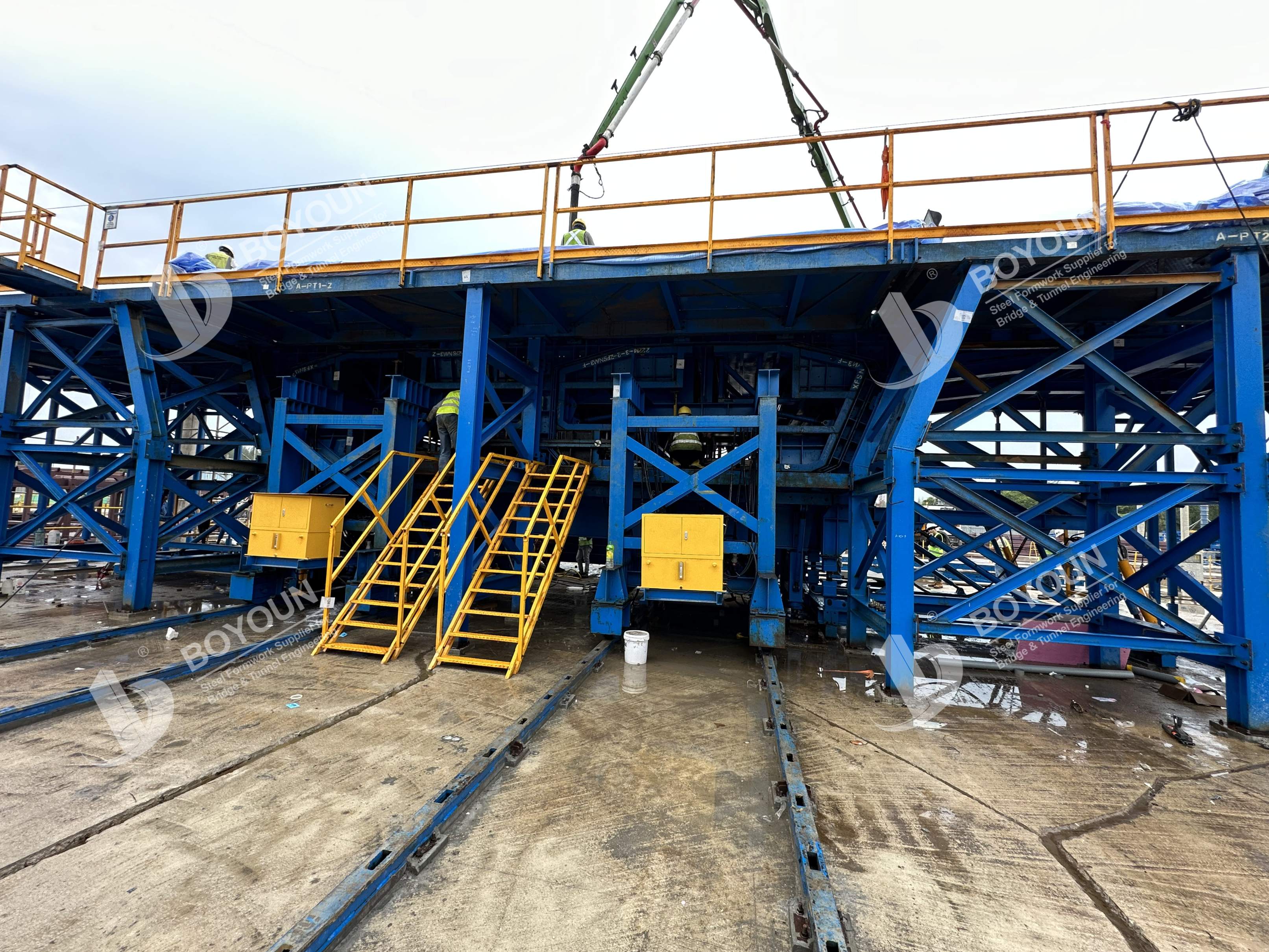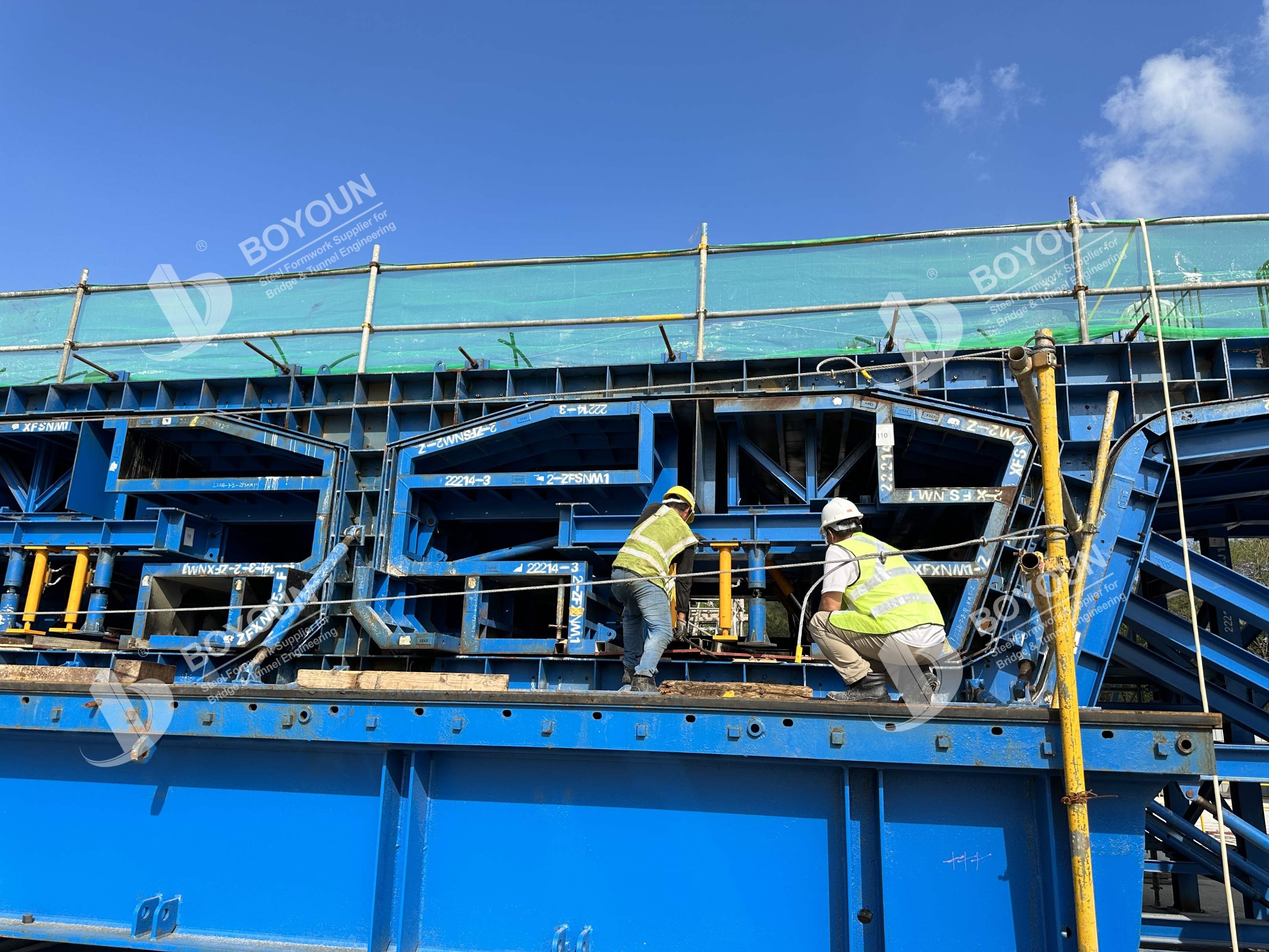The short-line precast of segmental box girders is one of the most important methods in the construction of prestressed concrete bridges in recent decades. It has the advantages of wide application range, low cost, fast progress, good quality, high degree of modularization and factory production. This article will introduce the key points of its construction operation.
(1) For the design and processing of trolley and formwork systems, a large and powerful processing factory should be selected with high precision requirements.
(2) The steel plate used must be thicker than 6mm.
(3) After the processing and production are completed, the trial assembly must be conducted in the factory to ensure that there are no problems before being assembled on site.

(1) Firstly, install the end form and support it with brackets to ensure that the entire end form is in a horizontal state.
(2) Install the side form, measure and set out the position of the side form bracket first, and then install it.
(3) Install the bottom form directly placed on the track through the small trolley.
(4) After the installation is completed, precisely adjust to make the misalignment between the forms less than 1mm.
(1) The new technology for skeleton positioning devices is used in the construction of reinforcement binding, which is welded with square steel. The bottom plate is directly placed on the ground, and the flange plate is welded to a square steel column and a steel plate for support. The reinforcement binding positioning frame for the bottom plate, web, and flange plate is an integral whole, and the reinforcement binding positioning bracket for the top plate is detachable and movable.
(2) The reinforcement binding is completed on the reinforcement binding skeleton device, and the preliminary positioning of the embedded parts is also completed. The suspension point of the reinforcement cage is processed with a Φ16mm reinforcement and firmly welded with the reinforcement cage. To ensure the reinforcement cage does not deform during the hoisting process, the reinforcement within the 60cm x 60cm around the suspension point and the reinforcement at the intersection of the web and the top plate are spot welded and reinforced.
(3) After the reinforcement cage is bound, it is hoisted into the qualified beam section formwork with a special reinforcement cage sling.
(4) When the reinforcement cage is placed in the formwork, first align the central axis of the reinforcement cage with the central axis of the formwork, and then use the electric hoist of the gantry crane to slowly lower the reinforcement cage into the adjusted formwork. In order to facilitate the adjustment of the anchor plate position of the web cantilever beam, a joint is set at about 50cm behind the anchor plate of the web cantilever beam. After the anchor plate and the anchor end formwork are adjusted, the joint is connected and wrapped with a corrugated pipe joint.
(5) The key point of the reinforcement process is the positioning of the corrugated pipe and embedded parts. All pipe fittings must be checked and adjusted after the reinforcement cage is placed in the formwork, and finally fixed to ensure their accurate position.

Due to the high measurement accuracy requirements of the matching beam, measures are taken to minimize the influence of unfavorable factors.
(1) Avoid measuring operations in winds above level 6.
(2) Avoid conducting measurement operations during high-temperature periods.
(3) Wrap the measuring tower in geotextiles to prevent direct sunlight and prevent temperature difference deformation between sunny and shady sides.
(4) Set up a sunshade on the measuring tower to block direct sunlight on the instrument.
(5) The measuring tower is equipped with steel pipe piles and the surrounding area is encased in concrete to reduce the impact of foundation settling on the measuring tower.
(6) During observation, two individuals independently gather data and average the values to reduce measurement error and improve accuracy.
First, bottom plate pouring. Second, web plate pouring: For the web plate, symmetrical blanking is adopted on both sides. Insertion vibrators are mainly used for vibration, and attached vibrators are used for auxiliary vibration at the bottom of the web plate. For beam sections with bottom plate anchorage blocks, special attention should be paid to the vibration of the concrete within the bottom plate anchorage blocks to ensure the compactness of the concrete at this position. Third, roof plate pouring: The roof plate concrete is continuously poured from one side to the other side, and insertion vibrators are used for vibration. When pouring concrete, the material is evenly distributed on both sides. During vibration, strictly operate according to the technical essentials of "quick insertion and slow extraction", and pay attention to observing the bubble discharge situation on the concrete surface, master the vibration time well, and ensure the pouring quality of the concrete. Fourth, surface finishing and roughening: Before the final setting of the concrete, conduct the surface finishing work of the top surface concrete, and make the surface into a common rough surface. Keep an eye on preventing the top surface concrete from cracking.
Concrete curing is carried out using concrete curing agents. After setting the concrete, spray the curing agent with a sprayer. The spraying should be uniform and the concrete surface should appear completely moist to the naked eye.
(1) According to construction experience and on-site tests, the box girder formwork of the segment can be removed once the concrete strength reaches 20MPa. When removing the formwork, first remove the inner formwork, then the outer formwork, and finally detach the matching surface.
Safety measures for formwork removal:
① Pay attention to the protection of finished products during formwork removal. Causing concrete defects due to rough construction is strictly prohibited.
② When operating the jacks on the bottom formwork trolley to detach the matching beam from the freshly poured beam, it must be operated in a jogging manner to avoid damaging the shear keys.
③ Templates that are not used after removal should be immediately cleaned, classified, and neatly stacked in the template storage yard, and must not be randomly placed everywhere.
(2) Transfer of matching beams: First, manually push the bottom formwork trolley to the bottom of the matching beam formwork, align the four vertical jacks with the limit device below the bottom formwork, jack up the jacks to make them stressed, then loosen the supporting legs of the matching beam bottom formwork, use a 5-ton winch to pull the matching beam to detach it from the freshly poured beam section and transfer it out, lower the supporting legs, release the jacks of the bottom formwork trolley, and replace the bottom formwork trolley under the bottom formwork of the freshly poured beam section.
(3) Transferring freshly poured beam sections: First, tighten the two diagonal braces fixed below the bottom formwork to detach the fixed bottom formwork from the bottom of the freshly poured beam section, and then transfer the freshly poured beam section outside the side formwork by the same method as transferring the matching beam.
(4) Before hoisting and storing the segmental box girders, conduct appearance inspection and repair first. The repair adopts a new technology of H-shaped steel support. Using H-shaped steel as the four-point support of the support for the external repair of the segmental box girders can quickly inspect and handle the appearance quality problems of the segmental box girders, achieving better results and ensuring the overall quality of the structure.
This article provides a comprehensive overview of the construction operation key points, including processing of trolleys and formworks, installation of end formworks, reinforcement construction, measurement and recheck, concrete pouring and curing, formwork removal, and beam section transfer and storage. Construction must strictly adhere to specifications, be meticulously carried out to guarantee project quality and contribute to the creation of high-quality projects!

International Department: Room 2211-2212, Tower C of Wanda Plaza, Tongzhou District, Beijing 101118, China.
+86-13021287080
info@boyoun.cn